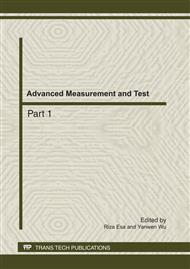[1]
Thomas F. Schubert Jr., Frank G. Jacobitz, and Ernest M. Kim, Exploring the Basic Principles of Electric Motors and Generators With a Low-Cost Sophomore-Level Experiment, IEEE Trans. on Education, Vol. 52, No. 1 (2009), pp.57-65.
DOI: 10.1109/te.2008.917195
Google Scholar
[2]
S. A. Shirsavar, Benjamin A. Potter, and Isabel M. Ridge, Three-Phase Mavhines and Drives- Equipment for a Laboratory-Based Course, IEEE Trans. on Education, Vol. 49, No. 3 (2006), pp.383-388.
DOI: 10.1109/te.2006.879266
Google Scholar
[3]
Robert S. Balog, Zakdy Sorchini, Jonathan W. Kimball, Patrick L. Chapman, and Philip T. Krein, Modern Laboratory-Based Education for Power Electronics and Electric Machines, IEEE Trans. on Power Systems, Vol. 20, No. 2 (2005), pp.538-547.
DOI: 10.1109/tpwrs.2005.846237
Google Scholar
[4]
Alon Kuperman and Raul Rabinovici, Virtual Torque and Inertia Loading of Controlled Electric Drive, IEEE Trans. on Education, Vol. 48, No. 1 (2005), pp.47-52.
DOI: 10.1109/te.2004.832881
Google Scholar
[5]
Edward Randolph Collins, An Energy Conversion Laboratory Using Industrial-Grade Equipment, IEEE Trans. on Power Systems, Vol. 24, No. 1 (2009), pp.3-11.
DOI: 10.1109/tpwrs.2008.2007006
Google Scholar
[6]
Tatsuya Kikuchi, Takashi Kenjo, and Shuichi Fukuda, Remote Laboratory for a Brushless DC Motor, IEEE Trans. on Education, Vol. 44, No. 2 (2001), pp.207-212.
DOI: 10.1109/13.925859
Google Scholar
[7]
Ercument Karakas and Satilmis Tekindal, The Effects of Computer-Assisted Learning in Teaching Permanent Magnet Synchronous Motors, IEEE Trans. on Education, Vol. 51, No. 4 (2008), pp.448-455.
DOI: 10.1109/te.2007.912546
Google Scholar
[8]
Ali Keyhani, Mohammad N. Marwali, Lauis E. Higuera, Geeta Athalye, and Gerald Baumgartner, An Integrated Virtual Learning System for the Development of Motor Drive Systems, IEEE Trans. on Power Systems, Vol. 17, No. 1 (2002), pp.1-6.
DOI: 10.1109/59.982185
Google Scholar
[9]
M. Ali Akcayol, Aydin Cetin, and Cetin Elmas, An Educational Tool for Fuzzy Logic-Controlled BDCM, IEEE Trans. on Education, Vol. 45, No. 1 (2002), pp.33-42.
DOI: 10.1109/13.983219
Google Scholar
[10]
Saffel Ayasun, and Chika O. Nwankpa, Induction Motor Tests Using MATLAB/Simulink and Their Integration into Undergraduate Electric Machinery Courses, IEEE Trans. on Education, Vol. 48, No. 1 (2005), pp.37-46.
DOI: 10.1109/te.2004.832885
Google Scholar
[11]
Jimmie J. Cathey, A MATLAB-Based Graphical Technique for Amortization Study of Adjustable Speed Drives, IEEE Trans. on Education, Vol. 45, No. 2 (2002), pp.177-181.
DOI: 10.1109/te.2002.1013884
Google Scholar
[12]
Khalid A. Nigim, and Ronald R. Delyser, Using MathCad in Understanding the Induction Motor Characteristics, IEEE Trans. on Education, Vol. 44, No. 2 (2001), pp.167-169.
DOI: 10.1109/13.925826
Google Scholar
[13]
Rui Hong Chu, Dylan Dan-Chuan Lu, and S. Sathiakumar, Project-Based Lab Teaching for Power Electronics and Drives, IEEE Trans. on Education, Vol. 51, No. 1 (2008), pp.108-113.
DOI: 10.1109/te.2007.906607
Google Scholar
[14]
Erkan Mese, Project-Oriented Adjustable Speed Motor Drive Course for Undergraduate Curricula, IEEE Trans. on Education, Vol. 49, No. 2 (2006), pp.236-246.
DOI: 10.1109/te.2006.872405
Google Scholar
[15]
Paul C. Krause, Oleg Wasynczuk, Scott D. Sudhoff, Analysis of Electric Machinery & Drive Systems, 2nd Edition, ISBN: 978-0-471-14326-0, Wiley-IEEE Press (2002).
DOI: 10.1109/9780470544167
Google Scholar
[16]
Chi-Hshiung Lin, A Structural Index to Affect the Operation Life of Steam Turbine Generators, International Journal of Circuit Theory and Applications, Vol. 36, No. 8 (2008), pp.923-938.
DOI: 10.1002/cta.474
Google Scholar


